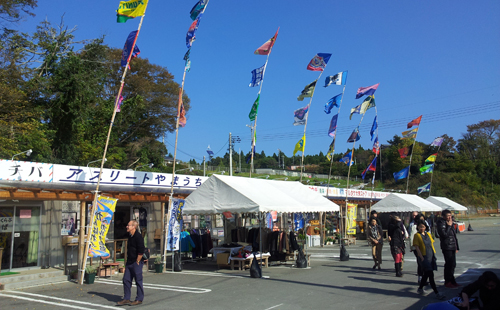Written by:
How can new housing be built in a way that ensures it is supported by local infrastructure?
While in Minamisanriku, we were shown a video of the tsunami hitting the area of Utatsu, taken by a local resident on his phone. It is not easy to watch. Most striking are both the noise and the speed of the destruction. Within minutes, you can see some 300 homes, 30 shops, roads and railway, cars and trees reduced to debris swirling around in huge torrents of water. They had predicted the height of the wave to be 6 metres. Instead, it was 15 metres high.
In July 2011, the union of local shopkeepers was approached by the local government and asked to help distribute supplies to those affected by the tsunami, which they did. But local people asked when they would have their shopping street back. This inspired the local shopkeepers to set up a temporary shopping street. Some of them owned their own land, but some who had to relocate had to bear costs despite government subsidy. The owner of the adjacent land made it available for parking and with help from the municipality, the land was flattened to accommodate it. All felt that the shopping street was not only an important practical resource for their community, but also a catalyst to help bring public life back to their community.

The Isatomae-Fuko Shopping Area opened with 10 shops in December 2011. The shopping street has also become a local attraction due to the colourful flags that wave from the shops. All of the teams from the Japanese football league have sent their clubs’ flags, signed by the members of the team, to this shopping street as a symbol of their solidarity. This has made the street not only a resource for local people, but also an attraction and destination for those from further afield.

As well as bringing back the shops, the union were keen to create a place where those in temporary housing could gather. They set up a stage where local businesses could promote their products, where they run cultural events, and where local people gather three times a month to talk about plans for reconstruction. These planning events are convened by local people and businesses and, though the local government is invited into these discussions, it is a community-led initiative.
However, this place was conceived as a temporary shopping street, and once the reconstruction of housing begins in earnest, the future and potential location of the shopping area is uncertain, as is its place on the list of priorities. Despite the obvious value it currently brings to the community, providing people with homes is the priority. Land allocation here is also complicated. Some land has subsided, legal boundaries have shifted and communities have been displaced.
This story raises questions that are relevant to the delivery of housing and shopping within the context of large-scale reconstruction or regeneration. Are there some lessons here about the role of public life and community activity in placemaking? Can temporary and community-driven solutions help ensure that people are rehoused as quickly as possible but that the right local infrastructure goes with it?
You can read the full collection of stories in this series in the publication Lessons from Minamisanriku: Stories of resilience and rebuilding.

Funded by the Arts and Humanities Research Council, ‘Bridging the Gap between Academic Theory and Community Relevance: Fresh Insights from American Pragmatism’ (AH/K006185/1) was a collaborative research project involving Keele University, Brunel University, the Open University, University of Edinburgh and Seinan Gakuin University (Japan), and community partners New Vic Borderlines and The Glass-House Community Led Design.

